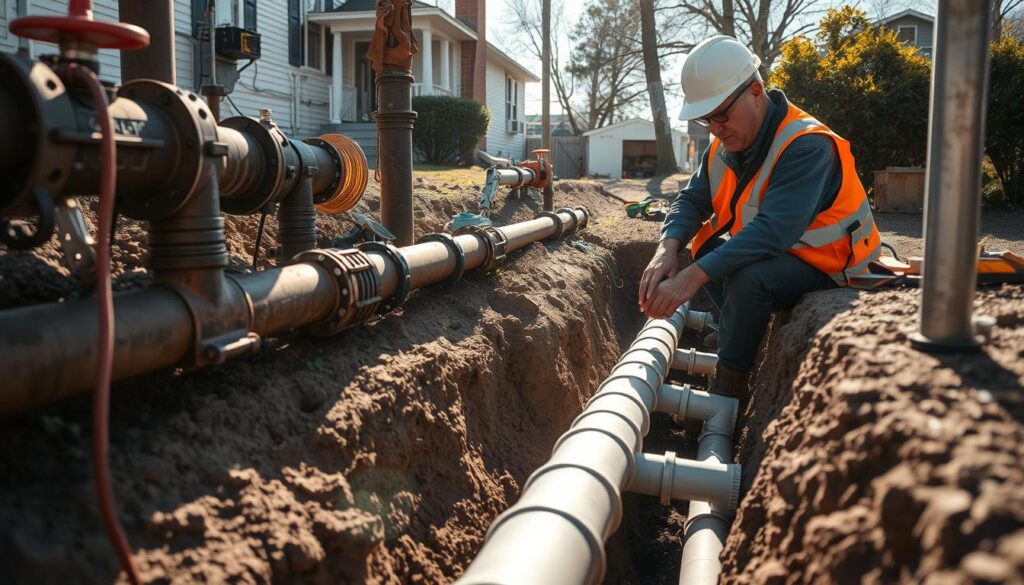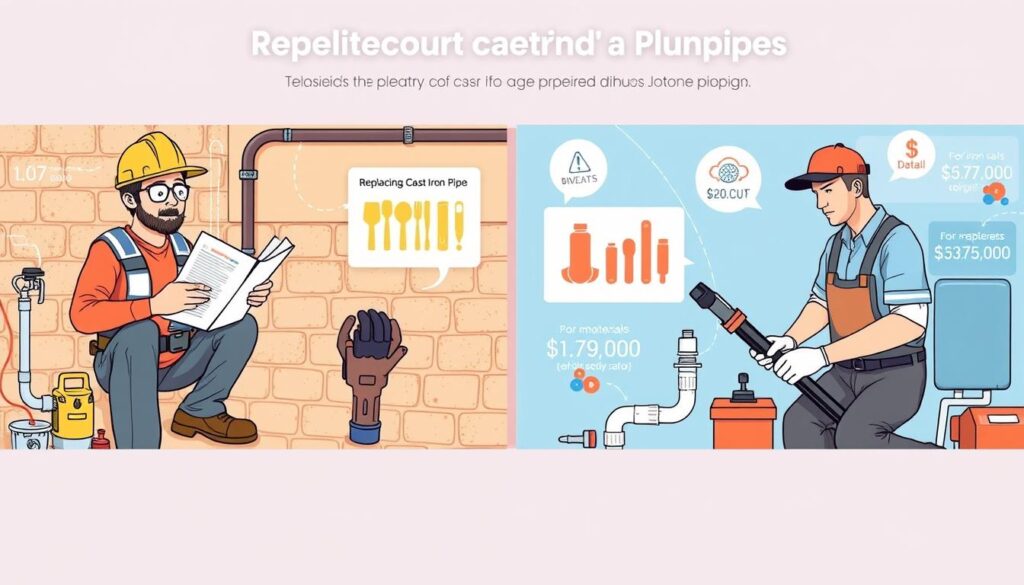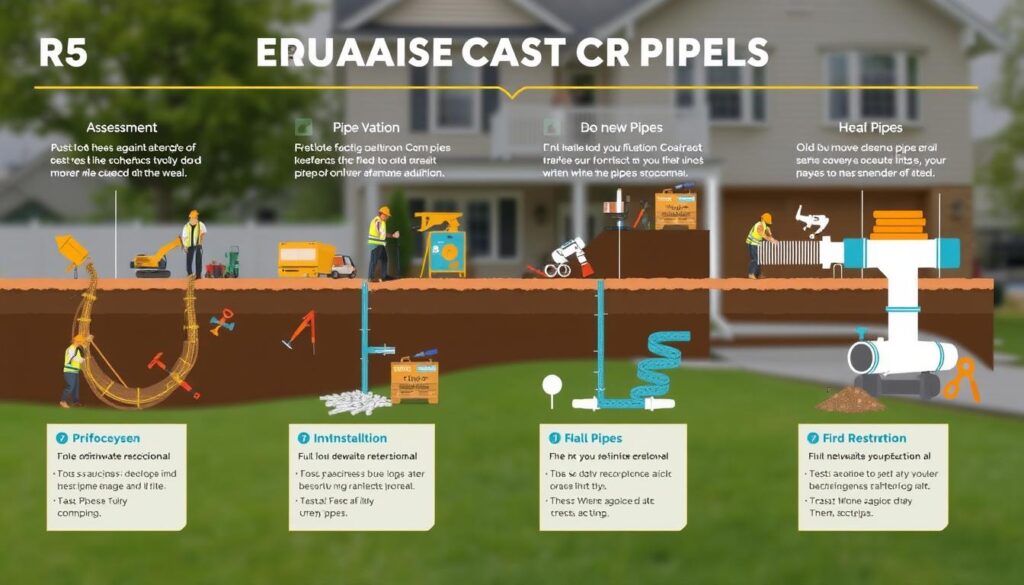Homeowners with old cast iron pipes often need to replace them. This is a big home improvement project that can affect your budget. This guide will help you understand the costs of replacing these pipes. It’s designed to help you plan and budget for this important home renovation in 2024.

Key Takeaways
- Understand the typical lifespan and common deterioration signs of cast iron pipes in modern homes.
- Explore the factors that influence the cost of cast iron pipe replacement, including labor, materials, and property size.
- Discover the latest replacement options, such as PVC and PEX, and compare their durability and installation methods.
- Evaluate the pros and cons of DIY versus professional replacement, and learn about available financing and insurance coverage options.
- Gain insights into the timeline and process of a cast iron pipe replacement project to better manage your home renovation expectations.
Understanding Cast Iron Pipe Systems in Modern Homes
Cast iron has been a key material for plumbing in homes for many years. It’s known for its strength and dependability. These pipes are essential in modern homes, moving water, waste, and other fluids. Knowing about cast iron pipes is important for homeowners to keep their plumbing in good shape.
Types of Cast Iron Pipes
There are different types of cast iron pipes used in homes. The most common ones are:
- Soil pipes: These handle waste and sewage from various fixtures.
- Vent pipes: They ensure the plumbing system vents properly, preventing odors.
- Drain pipes: These pipes carry wastewater from sinks and showers to the sewer line.
Common Installation Locations
Cast iron pipes are often found in certain areas of a home:
- Basement or crawl space: This is where the main sewer line and other pipes are usually located.
- Walls and ceilings: These pipes can be part of the home’s structure, running through walls and ceilings.
- Outdoors: Exterior pipes connect to the sewer system or septic tank.
Average Lifespan and Deterioration Signs
Cast iron pipes can last 50 to 100 years. But, they can start to show signs of wear and tear, such as:
- Rusting and corrosion
- Cracking or leaking
- Blockages from mineral buildup
- Failure of pipe joints and connections
Spotting these signs early can help homeowners fix problems before they get worse.
How Much Does it Cost to Replace Cast Iron Pipes
Replacing cast iron pipes can be a big expense for homeowners. Knowing the average costs helps you plan your budget. The total cost depends on your home’s size, the job’s complexity, and where you live.
The cost to replace cast iron pipes can range from $3,000 to $15,000. This wide range shows how different each project can be. Many factors can change the final price.
| Cost Factor | Average Range |
|---|---|
| Labor Costs | $50 – $150 per hour |
| Material Costs | $5 – $15 per linear foot |
| Property Size | $3,000 – $15,000 total |
Let’s look at what affects the cost of replacing cast iron pipes:
- Labor Costs: The cost of labor depends on the number of workers and their skills. Plumbers in cities usually charge more than those in rural areas.
- Material Prices: The cost of materials like PVC or copper pipes matters. The length and diameter of the pipes also affect the price.
- Property Size: Bigger homes need more pipes, making the job more expensive.
Understanding these factors helps homeowners estimate the cost of replacing cast iron pipes. It’s wise to talk to a professional plumber for a detailed quote for your project.
“The cost of a cast iron pipe replacement project can vary widely, but being informed about the factors that influence the pricing can help you make a more accurate budget.”
Factors That Influence Cast Iron Pipe Replacement Costs
Replacing cast iron pipes can cost differently based on several factors. Knowing these can help homeowners budget better for their plumbing projects.
Labor Costs by Region
The cost of labor for replacing cast iron pipes varies by region. This is due to the local cost of living, demand for plumbers, and other economic factors. In cities or areas with a high cost of living, plumbing labor rates tend to be higher.
Material Price Variations
The price of pipe material also affects the cost. Prices change due to global supply chains, commodity prices, and manufacturing costs. It’s important for homeowners to check current prices to get the best deal on pipe material costs.
Property Size and Pipe Accessibility
The size and layout of a home can also impact the cost. Larger homes with more plumbing or hard-to-reach pipes may cost more. This is because they need more labor and materials, leading to a higher home size impact on the total cost.
Understanding these factors helps homeowners work with plumbers to create a better budget for their cast iron pipe replacement needs.
Signs Your Cast Iron Pipes Need Replacement
Keeping your home’s plumbing in good shape is key to avoiding expensive water damage. It also helps your property last longer. Knowing the signs of plumbing damage indicators and pipe deterioration symptoms is crucial. This way, you can catch problems early and avoid bigger home maintenance issues.
Visible corrosion or rust on cast iron pipes is a clear warning sign. If you see pipes that are discolored or flaking, they’re breaking down. This could lead to leaks or even pipe failure. Also, if sinks and tubs drain slowly or get clogged often, it might mean the pipes are narrowing due to mineral buildup or damage.
- Discolored or flaking pipes – a sign of visible corrosion
- Frequent clogs or slow-draining sinks and tubs – indicating pipe constriction
- Discolored or rusty water – a potential sign of internal pipe corrosion
- Unexplained damp spots or water stains on walls or ceilings – a red flag for leaks
Seeing discolored or rusty water from your taps could mean internal pipe corrosion. This can affect your water quality. Also, if you find damp spots or water stains on walls or ceilings, it might be a sign of a hidden leak. Such leaks can cause serious water damage if not fixed.
By watching for these plumbing damage indicators and pipe deterioration symptoms, you can keep your cast iron pipes in good shape. This helps you avoid expensive emergency repairs later on.
Modern Replacement Options for Cast Iron Pipes
Homeowners are looking to update their plumbing with new materials. They want something more durable and easier to install than old cast iron pipes. PVC and PEX piping are now popular choices.
PVC vs. PEX Piping
PVC pipes are a favorite for being affordable and easy to put in. They resist corrosion and handle high pressure well. On the other hand, PEX pipes are flexible. This makes them great for tricky spaces and quick installations.
Durability Comparison
- PVC pipes can last up to 50 years with proper care.
- PEX pipes also last a long time, between 25 to 50 years, depending on the quality and how they’re installed.
Installation Methods
Installing PVC and PEX pipes is different. PVC needs soldering and gluing, which can be more work. PEX, however, uses expansion fittings or crimp connections. This makes it faster and easier for DIY projects.
| Feature | PVC Piping | PEX Piping |
|---|---|---|
| Lifespan | Up to 50 years | 25 to 50 years |
| Installation Complexity | Moderate to High | Low to Moderate |
| Cost | Lower | Higher |
Choosing between PVC and PEX pipes involves considering durability, installation, and cost. Understanding the pros and cons of each helps homeowners make a choice that fits their budget and plumbing needs.
DIY vs. Professional Replacement: Cost Breakdown
Homeowners often wonder if they should replace cast iron pipes themselves or call a plumber. The cost difference between DIY and hiring a pro can be big.
DIY plumbing might seem like a way to save money. But, the real costs of DIY can add up quickly. You’ll need to buy tools and materials and spend time on the job. Plus, there’s a chance you could make mistakes that cost more later.
| Factors | DIY Plumbing | Professional Pipe Installation |
|---|---|---|
| Labor Costs | $0 (Your Time) | $50 – $150 per hour |
| Material Costs | $500 – $2,000 | $800 – $3,000 |
| Potential Risks | Leaks, Flooding, Structural Damage | Minimal Risks |
| Warranty and Guarantees | None | 1-5 years on Labor and Materials |
Hiring a plumber might cost more upfront. But, it comes with many benefits. Professionals do the job right and fast. They also offer warranties and can fix problems quickly. Plus, they can prevent future issues, saving you money later.
Choosing between DIY and hiring a pro depends on your skills, time, and risk tolerance. Think about the costs and potential problems. This way, you can decide what’s best for your budget and needs.

Insurance Coverage and Financing Options
Replacing cast iron pipes can be expensive for homeowners. But, there are insurance policies and financing options to help. We’ll look at common insurance, payment plans, and government aid to support you.
Common Insurance Policies
Homeowner’s insurance might cover the cost of replacing cast iron pipes. This is true if the pipes have worn out or were damaged suddenly. Here are some policies to consider:
- Homeowner’s Insurance: This policy can help if a pipe bursts unexpectedly.
- Sewer and Drain Coverage: An optional add-on for underground pipe repairs or replacements.
- Water Backup Coverage: Helps with damage from sewer or drain backups.
Available Payment Plans
If insurance doesn’t cover enough, there are other ways to pay for pipe replacement:
- Home Equity Loans: Borrow against your home’s equity at a lower rate.
- Personal Loans: Banks and online lenders offer loans with good rates and flexible terms.
- Payment Plans with Contractors: Some plumbers offer financing or payment plans to spread out the cost.
Government Assistance Programs
There are also government programs for home repair financing and plumbing insurance:
- Local Home Repair Grants: Many cities offer grants or low-interest loans for repairs like pipe replacement.
- Federal Housing Assistance: HUD’s Section 504 program helps low-income homeowners with repairs.
By looking into these options, you can find a way to afford replacing your cast iron pipes. This will keep your home’s plumbing system healthy for years to come.
Timeline and Process of Pipe Replacement
Replacing cast iron pipes in your home is a big job. It needs careful planning and execution. Knowing the timeline and process helps manage your plumbing renovation timeline. It ensures a smooth pipe replacement process in your home improvement project management.
The time it takes to replace cast iron pipes varies. It depends on the project’s size, pipe accessibility, and the plumber’s schedule. A small project, like replacing pipes in one bathroom, might take 2-3 days. But, a whole-house replacement can take 1-2 weeks or more, based on your home’s size and complexity.
The pipe replacement process includes several steps:
- Initial inspection and assessment: Your plumber will check the existing cast iron pipes. They’ll plan how to replace them.
- Preparation and planning: Your plumber will make a detailed project plan. This includes a timeline, work schedule, and necessary permits.
- Pipe demolition and removal: The old cast iron pipes will be carefully removed. This minimizes disruption to your home.
- Installation of new pipes: Your plumber will install new pipes. These might be PVC or PEX, based on your choice and local codes.
- Reconnection and testing: The new pipes will be connected to your plumbing system. They’ll be tested to ensure they work properly.
- Cleanup and restoration: Your plumber will clean up and restore your home. They’ll make sure everything is back to normal.
During the plumbing renovation timeline, it’s important to communicate with your plumber. They can give you updates, address concerns, and keep the pipe replacement process on track in your home improvement project management.

| Project Size | Estimated Timeline |
|---|---|
| Single Bathroom | 2-3 days |
| Whole House | 1-2 weeks or longer |
Preventing Future Cast Iron Pipe Issues
Keeping your plumbing system in good shape is key to its long life and avoiding expensive fixes. Regular checks and taking action early can help keep your pipes strong. This way, you can avoid costly repairs later on.
Watching the quality of your water is also important. Things like mineral buildup and pH imbalances can harm your pipes. Using a water filter and testing your water often can help protect your pipes.
How you use your plumbing matters too. Don’t throw away harsh chemicals, grease, or other things that could damage your pipes. Cleaning your drains and fixtures regularly helps keep your plumbing system healthy.
FAQ
What are the common types of cast iron pipes used in modern homes?
Modern homes often use hub and spigot, no-hub, and sand cast iron pipes.
Where are cast iron pipes typically installed in a home?
You’ll find them in sewer lines, drain lines, and ventilation systems.
How long do cast iron pipes typically last?
They usually last 50-80 years. But, it depends on water quality and upkeep.
What are the common signs that cast iron pipes need replacement?
Look out for frequent clogs, corrosion, water color changes, and leaks.
What are the modern replacement options for cast iron pipes?
PVC and PEX piping are popular. They’re durable and cost-effective.
How do the costs of DIY and professional cast iron pipe replacement compare?
DIY is cheaper but riskier. Professionals are more expensive but safer.
What insurance policies or financing options are available for cast iron pipe replacement?
Insurance might cover some costs. There are loans and government help too.
How long does the cast iron pipe replacement process typically take?
It takes 2-5 days for small projects. Larger ones might take up to 2 weeks.
What can homeowners do to prevent future cast iron pipe issues?
Regular checks, upkeep, and good water quality can help pipes last longer.
